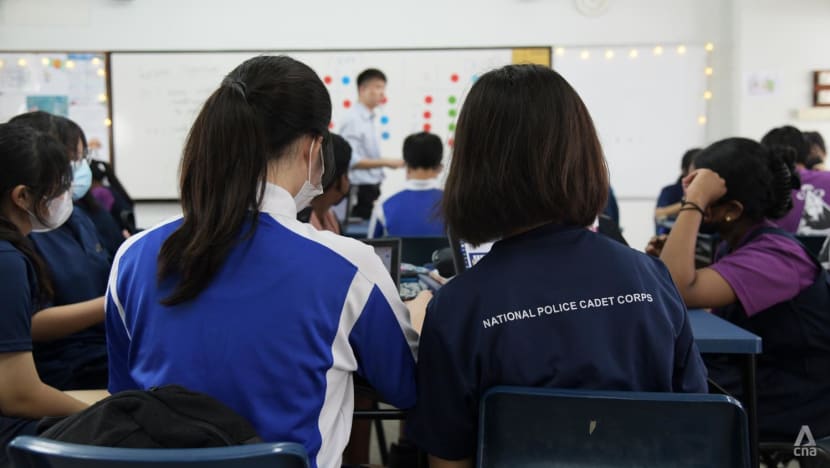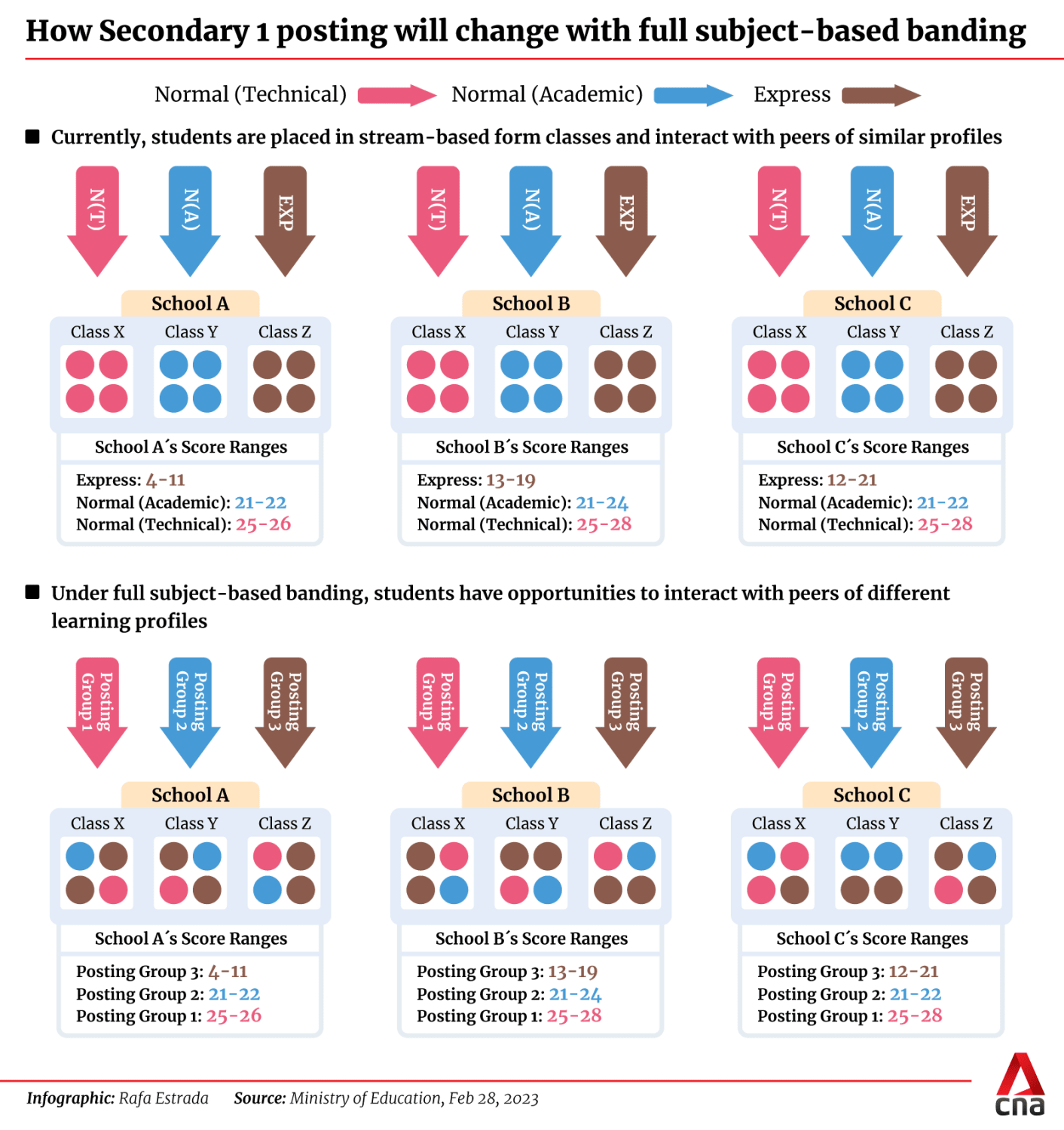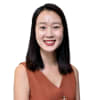CNA Explains: What you need to know about full subject-based banding
Mixed form classes, different subject levels and posting groups - here's how all these will come together under the new scheme from 2024.

Secondary 2 students in their math subject-level class at Jurong West Secondary School. (Photo: CNA/Raydza Rahman)
SINGAPORE: From 2024, full subject-based banding will be rolled out to 120 schools across Singapore.
At the Committee of Supply debates on Wednesday (Mar 1), Minister for Education Chan Chun Sing announced changes to how students would be posted to secondary schools.
Other measures like mixed form classes, and allowing students to take subjects at a more or less demanding level will also be implemented.
Confused about how all the new measures come together? Here’s what you need to know.
What exactly is subject-based banding?
The concept of subject-based banding was introduced in 2019, when it was announced that the system would replace the existing Express, Normal (Academic) and Normal (Technical) streams from 2024.
A total of 28 secondary schools began piloting it in 2020 - testing out new ways of organising students from different academic streams into the same form class.
Another key idea was to allow students to take subjects at a higher or lower level based on their strengths.
In 2022, MOE announced that these different subject levels would be labelled G3, G2 and G1, mapped from today’s Express, N(A) and N(T) standards. G stands for General.
Currently, students in schools that have already implemented subject-based banding can take English, mathematics, science and mother tongue at a higher level in Secondary 1 if they have done well in the subjects at the PSLE.
Some students in those schools who did well in these subjects later on in secondary school have also been offered the option to take them at a higher level.
With the rollout of full subject-based banding across all eligible schools, this option will be expanded to humanities subjects at Secondary 2 from 2024.
What is a posting group?
After students take the Primary School Leaving Examination (PSLE), their results will reflect whether they are in posting groups 3, 2 or 1.
Like the new subject levels, the new posting groups 3, 2 and 1 are mapped to the existing PSLE score ranges for the Express, N(A) and N(T) streams respectively. They will be used to facilitate school admission and guide the subject levels students offer at the start of the year, but will not affect the student’s school life after that.

Students who score between 4 and 20 points will be in posting group 3, and those who score between 23 and 24 points will be in posting group 2.
Those who score 26 to 30 points, with an Achievement Level of 7 in English and mathematics, will be in posting group 1.
Students who score 21 or 22 points will be put in an option band, and can choose to apply as a student from posting group 2 or 3. Students who score 25 points can choose between applying under posting group 1 or 2, the Education Ministry said.
How does this affect Sec 1 posting?
A student should consider their posting group and PSLE score when applying for entry into secondary school.
For example, a student who scores 10 points for PSLE will be put in posting group 3. This student can then consider schools that accept students from posting group 3.
They should also consider their PSLE score and how it compares to the schools’ cut-off ranges when listing their school choices. With a score of 10, it may be more difficult to get into a school that has a cut-off point range of 4 to 8, but easier to score a spot in a school with a cut-off point range of 6 to 12.
Students who are put in the option bands can choose to apply to schools that accept either posting group.
Currently, students who score within the option bands can already choose to apply for schools at an Express or N(A) level, and N(A) or N(T) level respectively. Each school will continue to have a different cut-off point range for each posting group it accepts.
For example, those in the first option band may apply to Springfield Secondary School, which accepts students from posting groups 1, 2 and 3 from 2024.
They can choose to apply under posting group 2 or 3, depending on how their score compares to the school’s cut-off point ranges.
Students may then go on to enter the school under posting group 2, and eventually take some subjects at a higher level.
What about the subjects?
The posting group that the student enters the school under will determine the level of most of the subjects they take.
For example, a student who enters a school under posting group 2 will take most of their subjects at G2 at the start of the year.
Depending on their PSLE results for the various subjects, they may also be offered a chance to take English, math, science or mother tongue at the G3 level from the start.
If they do well later on, they may be offered a chance to go from G2 to G3 for their other subjects too.
This means that a student that enters a school under posting group 2 and starts off with mostly G2 subjects may eventually take many, or even all their subjects at the G3 level as they progress through secondary school.
What if students find the subject too difficult?
Students can also choose to take subjects at a less demanding level if they are not coping well.
From 2024, students entering Secondary 1 who face exceptional difficulties with mother tongue will have the option to offer it at a less demanding level, at G1 or G2.
Students who are offered English, math or science at Foundation level at PSLE, but are otherwise eligible to take most of their subjects at G3 in secondary school, can choose to take those subjects at a less demanding level, or G2, after consulting with their schools.
They can further adjust these subject levels as they progress through secondary school.
From 2026, some subjects will also be offered as electives at more demanding or less demanding levels.
For example, computer applications is currently a standalone subject for lower secondary N(T) students.
This will be discontinued, and computing will be offered as an elective subject for all upper secondary students from 2026, when the Secondary 1 batch of 2024 reaches Secondary 3.
From the 2024 Secondary 1 cohort, social studies for the N(T) stream will also be discontinued, and replaced by G1 humanities, which is non-examinable.
Most of the elective subjects taken at the upper secondary level are examinable, and there are some elective subjects, like History, that are not offered at the G1 level, said MOE.
About 80 per cent of secondary schools will implement full subject-based banding.
The remaining schools include integrated programme schools such as Raffles Institution, which only accept students from posting group 3 – currently the Express stream. Crest Secondary School will also remain a specialised school that offers a customised curriculum for students in posting group 1 – currently the Normal (Technical) stream.
However, these schools can still allow students to take subjects at a more demanding or less demanding level.
What is a mixed form class? How will the subjects be taught?
In schools that take in students from multiple posting groups, form classes will be mixed – each form class will be made up of students from different posting groups, taking subjects at different levels.
In lower secondary, students will take six common curriculum subjects in their mixed form classes – art, design and technology, food and consumer education, music, physical education and character and citizenship education.

But for their core subjects, students will take them in classes according to their subject level. Since the subject classes are organised based on the students’ subject level, those from different form classes may meet and learn together for their core subjects.
This means a subject class could be made up of students from posting groups 2 and 3 across different form classes, with all of them taking the subject at a G3 level.
What happens after secondary school?
Previously, without mixed form classes and full subject-based banding, a school that accepted students from all three streams would typically see separate classes made up of only Express students, N(A) students or N(T) students.
These students would also only take subjects at the level of their stream and then take the corresponding O-Level or N-Level examinations.
With full subject-based banding implemented across 120 schools from next year, students will sit for a common Singapore-Cambridge Secondary Education Certificate (SEC) exam from 2027, regardless of their initial posting group.
The SEC will replace the current O-Level and N-Level certificates, which current students sit for at the end of four or five years in secondary school.
The option of spending a fifth year in secondary school will remain available to students who want to take subjects at a more demanding level.
While the current admission criteria for junior colleges will remain, there will be changes to the admission criteria for the Polytechnic Foundation Programme.
The Polytechnic Foundation Programme currently takes in Secondary 4 N(A) students who have taken the N-Level examinations. The programme prepares them to progress into selected polytechnic diploma courses, and serves as an alternative to a fifth year in secondary school.
The intake for the programme will be expanded to students taking G3 subjects or a mix of G3 and G2 subjects from 2028. This will increase the number of students accepted each year to 2,600 from 1,700.
With this change, students can apply to the programme regardless of posting group, as long as their eventual subject combinations meet the criteria.
The Education Ministry is also reviewing the polytechnic Year 1 admission criteria to better recognise the different subject levels taken by students.
For example, students today have to take five G3 subjects to be eligible for polytechnic Year 1.
With full subject-based banding, some may take subjects at the G2 level. MOE is also exploring allowing one G2 subject to be considered for admission.
















